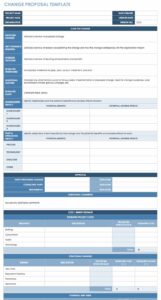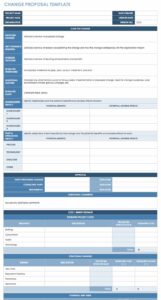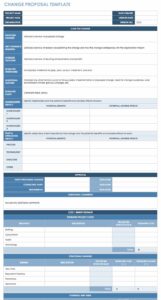Utilizing standardized forms for software modifications brings several advantages. Improved communication among stakeholders, reduced ambiguity in requests, and better traceability of changes are key benefits. Formalized documentation also contributes to a more organized development process, leading to increased efficiency, fewer errors, and higher quality outcomes. Additionally, these forms aid in prioritizing changes and allocating resources effectively.
The following sections will delve deeper into the core components of effective modification documentation, explore best practices for implementation, and discuss strategies for tailoring the process to different project needs.
Key Components of a Change Request Form
Effective change management relies on comprehensive and well-structured documentation. Clearly defined fields within a change request form ensure consistent capture of critical information, streamlining the evaluation and implementation process.
1: Unique Identifier: A unique number or code allows for easy tracking and referencing of the request throughout the development lifecycle.
2: Request Date: Timestamping the request provides valuable context and helps track the progress of modifications.
3: Requestor: Identifying the individual or team initiating the change clarifies responsibility and facilitates communication.
4: Description of Change: A detailed explanation of the desired modification, including its purpose and scope, is crucial for clear understanding.
5: Rationale: Justifying the change explains its necessity and helps stakeholders assess its value and potential impact.
6: Impact Assessment: Evaluating the potential effects of the change on functionality, performance, and other system aspects allows for informed decision-making.
7: Priority Level: Assigning a priority level (e.g., critical, high, medium, low) helps prioritize tasks and allocate resources efficiently.
8: Affected Components: Identifying the specific modules, functionalities, or system parts impacted by the change enables targeted implementation and testing.
These components, when combined, provide a structured framework for requesting and managing changes, ensuring clarity, traceability, and efficient implementation throughout the software development process. Thorough documentation supports informed decision-making and contributes to successful project outcomes.
How to Create a Change Request Template
Developing a standardized change request template ensures consistency and clarity in managing software modifications. A well-structured template facilitates efficient communication and implementation of changes throughout the development lifecycle.
1: Define Scope and Purpose: Clearly outline the types of changes the template will cover. Consider project-specific requirements and tailor the template to address these needs effectively.
2: Establish Required Fields: Include essential fields such as a unique identifier, request date, requestor, description of the change, rationale, impact assessment, priority level, and affected components.
3: Choose a Format: Select a suitable format (e.g., digital form, spreadsheet, document) based on project requirements and accessibility. Digital formats often offer advantages in terms of automation and tracking.
4: Design for Clarity and Ease of Use: Structure the template logically to ensure easy navigation and comprehension. Use clear and concise language for field labels and instructions.
5: Implement Version Control: Track template versions to maintain a record of changes and ensure everyone uses the most up-to-date version.
6: Integrate with Workflow: Align the template with existing project management workflows to facilitate seamless integration and processing of change requests.
7: Train Stakeholders: Provide training to all stakeholders on how to complete and submit change requests using the template. This ensures consistent usage and accurate data capture.
A well-designed template promotes efficient communication, simplifies the change management process, and reduces potential errors or misinterpretations. Consistent application of the template throughout the project lifecycle contributes to improved project outcomes.
Standardized change request templates provide a crucial framework for managing modifications throughout the software development lifecycle. From initial request through implementation and review, a structured approach ensures clarity, traceability, and efficiency. Key components such as unique identifiers, detailed descriptions, impact assessments, and priority levels enable informed decision-making and streamlined processing. Careful template design, coupled with stakeholder training and integration with existing workflows, maximizes effectiveness. Ultimately, adherence to well-defined processes fosters better communication, reduces errors, and contributes significantly to successful project delivery.
Effective change management is essential for navigating the evolving landscape of software development. Investing in robust processes and standardized documentation empowers teams to adapt to changing requirements while maintaining project quality and delivering optimal results. Continuous improvement and adaptation of these processes are crucial for staying ahead in a dynamic development environment.


